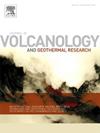Effects of lateral dyke propagation and pre-existing fractures on shallow deformation: Data from the Etna 1947 eruption and analogue models
IF 2.3
3区 地球科学
Q2 GEOSCIENCES, MULTIDISCIPLINARY
Journal of Volcanology and Geothermal Research
Pub Date : 2025-04-30
DOI:10.1016/j.jvolgeores.2025.108349
引用次数: 0
Abstract
Mount Etna, one of Europe's most active volcanoes, has experienced a variety of eruption settings throughout its history, including summit, lateral, and eccentric eruptions. In this study, we provide a detailed analysis of the structures formed during the 1947 lateral eruption, along the NE Rift, using historical aerial photos and accounts, archival images, and contemporary field and drone data. Photogrammetric processing of 1932 and 1954 aerial photos enabled us to map the structures formed before and during the eruption, in order to examine the effects of pre-existing fractures on the 1947 deformation pattern. With the aid of field surveys, we studied 90 normal faults, 194 dry fractures and 17 eruptive fissures, collecting data on the structures' length, azimuth, vertical offset, vectors and amount of opening. The reconstruction of a detailed chronology of the eruption's day-by-day development, allowed us to characterize the event as a NE-directed, lateral propagation of magma along a N-S to NE-SW-striking dyke, which followed the path of a previous similar event. Based on the reconstruction of the fault-slip profiles at both sides of various 1947 grabens, we were able to show that fault scarps taper towards NE. Analogue models were also used to simulate the lateral intrusions of dykes and the consequent formation of shallow structures. All the data suggest that the formation of the various structures, with different geometry and deformation, depends upon a combination of magma overpressure, local topography, external stresses, pre-existing structures, and direction of magma propagation.
侧向岩脉扩展和预先存在的裂缝对浅层变形的影响:来自埃特纳火山1947年喷发的数据和模拟模型
埃特纳火山是欧洲最活跃的火山之一,在其历史上经历了各种各样的喷发环境,包括山顶喷发、横向喷发和偏心喷发。在这项研究中,我们使用历史航空照片和记录、档案图像以及当代野外和无人机数据,对1947年沿东北裂谷横向喷发期间形成的结构进行了详细分析。对1932年和1954年的航空照片进行摄影测量处理,使我们能够绘制出火山喷发前和喷发期间形成的结构,以便检查先前存在的裂缝对1947年变形模式的影响。在野外调查的基础上,研究了90条正断层、194条干裂缝和17条喷发裂缝,收集了构造的长度、方位、垂直偏移量、矢量和张开量等数据。通过对喷发逐日发展的详细年表的重建,我们可以把这次喷发描述为一次北东向的岩浆沿北南向北西向的岩脉横向传播,它遵循了之前类似事件的路径。通过对1947年各地堑两侧断滑剖面的重建,我们可以看出断崖向北东逐渐变细。模拟模型还用于模拟岩脉的侧向侵入和由此形成的浅层构造。所有数据表明,具有不同几何形状和变形的各种构造的形成取决于岩浆超压、局部地形、外部应力、原有构造和岩浆传播方向的综合作用。
本文章由计算机程序翻译,如有差异,请以英文原文为准。
求助全文
约1分钟内获得全文
求助全文
来源期刊
CiteScore
5.90
自引率
13.80%
发文量
183
审稿时长
19.7 weeks
期刊介绍:
An international research journal with focus on volcanic and geothermal processes and their impact on the environment and society.
Submission of papers covering the following aspects of volcanology and geothermal research are encouraged:
(1) Geological aspects of volcanic systems: volcano stratigraphy, structure and tectonic influence; eruptive history; evolution of volcanic landforms; eruption style and progress; dispersal patterns of lava and ash; analysis of real-time eruption observations.
(2) Geochemical and petrological aspects of volcanic rocks: magma genesis and evolution; crystallization; volatile compositions, solubility, and degassing; volcanic petrography and textural analysis.
(3) Hydrology, geochemistry and measurement of volcanic and hydrothermal fluids: volcanic gas emissions; fumaroles and springs; crater lakes; hydrothermal mineralization.
(4) Geophysical aspects of volcanic systems: physical properties of volcanic rocks and magmas; heat flow studies; volcano seismology, geodesy and remote sensing.
(5) Computational modeling and experimental simulation of magmatic and hydrothermal processes: eruption dynamics; magma transport and storage; plume dynamics and ash dispersal; lava flow dynamics; hydrothermal fluid flow; thermodynamics of aqueous fluids and melts.
(6) Volcano hazard and risk research: hazard zonation methodology, development of forecasting tools; assessment techniques for vulnerability and impact.

 求助内容:
求助内容: 应助结果提醒方式:
应助结果提醒方式:


